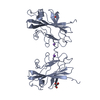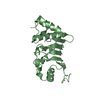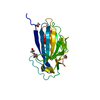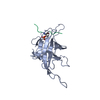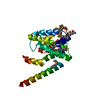[English] 日本語
 Yorodumi
Yorodumi- SASDAC6: PsrP functional binding region (Functional binding region (187-38... -
+ Open data
Open data
- Basic information
Basic information
| Entry | Database: SASBDB / ID: SASDAC6 |
|---|---|
 Sample Sample | PsrP functional binding region
|
| Function / homology |  Function and homology information Function and homology informationGram-positive-bacterium-type cell wall / symbiont-mediated perturbation of host defense response / single-species biofilm formation / cell adhesion / cell surface / DNA binding / extracellular region Similarity search - Function |
| Biological species |  |
 Citation Citation |  Journal: Sci Rep / Year: 2016 Journal: Sci Rep / Year: 2016Title: The BR domain of PsrP interacts with extracellular DNA to promote bacterial aggregation; structural insights into pneumococcal biofilm formation. Authors: Tim Schulte / Cecilia Mikaelsson / Audrey Beaussart / Alexey Kikhney / Maya Deshmukh / Sebastian Wolniak / Anuj Pathak / Christine Ebel / Jonas Löfling / Federico Fogolari / Birgitta ...Authors: Tim Schulte / Cecilia Mikaelsson / Audrey Beaussart / Alexey Kikhney / Maya Deshmukh / Sebastian Wolniak / Anuj Pathak / Christine Ebel / Jonas Löfling / Federico Fogolari / Birgitta Henriques-Normark / Yves F Dufrêne / Dmitri Svergun / Per-Åke Nygren / Adnane Achour /      Abstract: The major human pathogen Streptococcus pneumoniae is a leading cause of disease and death worldwide. Pneumococcal biofilm formation within the nasopharynx leads to long-term colonization and ...The major human pathogen Streptococcus pneumoniae is a leading cause of disease and death worldwide. Pneumococcal biofilm formation within the nasopharynx leads to long-term colonization and persistence within the host. We have previously demonstrated that the capsular surface-associated pneumococcal serine rich repeat protein (PsrP), key factor for biofilm formation, binds to keratin-10 (KRT10) through its microbial surface component recognizing adhesive matrix molecule (MSCRAMM)-related globular binding region domain (BR187-385). Here, we show that BR187-385 also binds to DNA, as demonstrated by electrophoretic mobility shift assays and size exclusion chromatography. Further, heterologous expression of BR187-378 or the longer BR120-378 construct on the surface of a Gram-positive model host bacterium resulted in the formation of cellular aggregates that was significantly enhanced in the presence of DNA. Crystal structure analyses revealed the formation of BR187-385 homo-dimers via an intermolecular β-sheet, resulting in a positively charged concave surface, shaped to accommodate the acidic helical DNA structure. Furthermore, small angle X-ray scattering and circular dichroism studies indicate that the aggregate-enhancing N-terminal region of BR120-166 adopts an extended, non-globular structure. Altogether, our results suggest that PsrP adheres to extracellular DNA in the biofilm matrix and thus promotes pneumococcal biofilm formation. |
 Contact author Contact author |
|
- Structure visualization
Structure visualization
| Structure viewer | Molecule:  Molmil Molmil Jmol/JSmol Jmol/JSmol |
|---|
- Downloads & links
Downloads & links
-Models
| Model #565 | 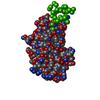 Type: mix / Software: EOM (1.3) / Radius of dummy atoms: 1.90 A / Chi-square value: 0.974169  Search similar-shape structures of this assembly by Omokage search (details) Search similar-shape structures of this assembly by Omokage search (details) |
|---|---|
| Model #566 | 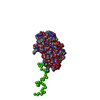 Type: mix / Software: EOM (1.4) / Radius of dummy atoms: 1.90 A / Chi-square value: 0.974169  Search similar-shape structures of this assembly by Omokage search (details) Search similar-shape structures of this assembly by Omokage search (details) |
- Sample
Sample
 Sample Sample | Name: PsrP functional binding region / Specimen concentration: 2.9 mg/ml |
|---|---|
| Buffer | Name: PBS / pH: 7.4 / Comment: Phosphate buffered saline / Composition: Glycerol 5.000 % |
| Entity #37 | Name: PsrP BR(187-385) / Type: protein Description: Functional binding region (187-385) of the pneumococcal serine-rich repeat protein Formula weight: 22.12 / Num. of mol.: 1 / Source: Streptococcus pneumoniae / References: UniProt: A0A0H2URK1 Sequence: HHHHHHSGNT IVNGAPAINA SLNIAKSETK VYTGEGVDSV YRVPIYYKLK VTNDGSKLTF TYTVTYVNPK TNDLGNISSM RPGYSIYNSG TSTQTMLTLG SDLGKPSGVK NYITDKNGRQ VLSYNTSTMT TQGSGYTWGN GAQMNGFFAK KGYGLTSSWT VPITGTDTSF ...Sequence: HHHHHHSGNT IVNGAPAINA SLNIAKSETK VYTGEGVDSV YRVPIYYKLK VTNDGSKLTF TYTVTYVNPK TNDLGNISSM RPGYSIYNSG TSTQTMLTLG SDLGKPSGVK NYITDKNGRQ VLSYNTSTMT TQGSGYTWGN GAQMNGFFAK KGYGLTSSWT VPITGTDTSF TFTPYAARTD RIGINYFNGG GKVVESSTTS QSLSQ |
-Experimental information
| Beam | Instrument name: ESRF BM29 / City: Grenoble / 国: France  / Type of source: X-ray synchrotron / Wavelength: 0.09919 Å / Dist. spec. to detc.: 2.43 mm / Type of source: X-ray synchrotron / Wavelength: 0.09919 Å / Dist. spec. to detc.: 2.43 mm | ||||||||||||||||||||||||||||||
|---|---|---|---|---|---|---|---|---|---|---|---|---|---|---|---|---|---|---|---|---|---|---|---|---|---|---|---|---|---|---|---|
| Detector | Name: Pilatus 1M | ||||||||||||||||||||||||||||||
| Scan |
| ||||||||||||||||||||||||||||||
| Distance distribution function P(R) |
| ||||||||||||||||||||||||||||||
| Result |
|
 Movie
Movie Controller
Controller

 SASDAC6
SASDAC6
